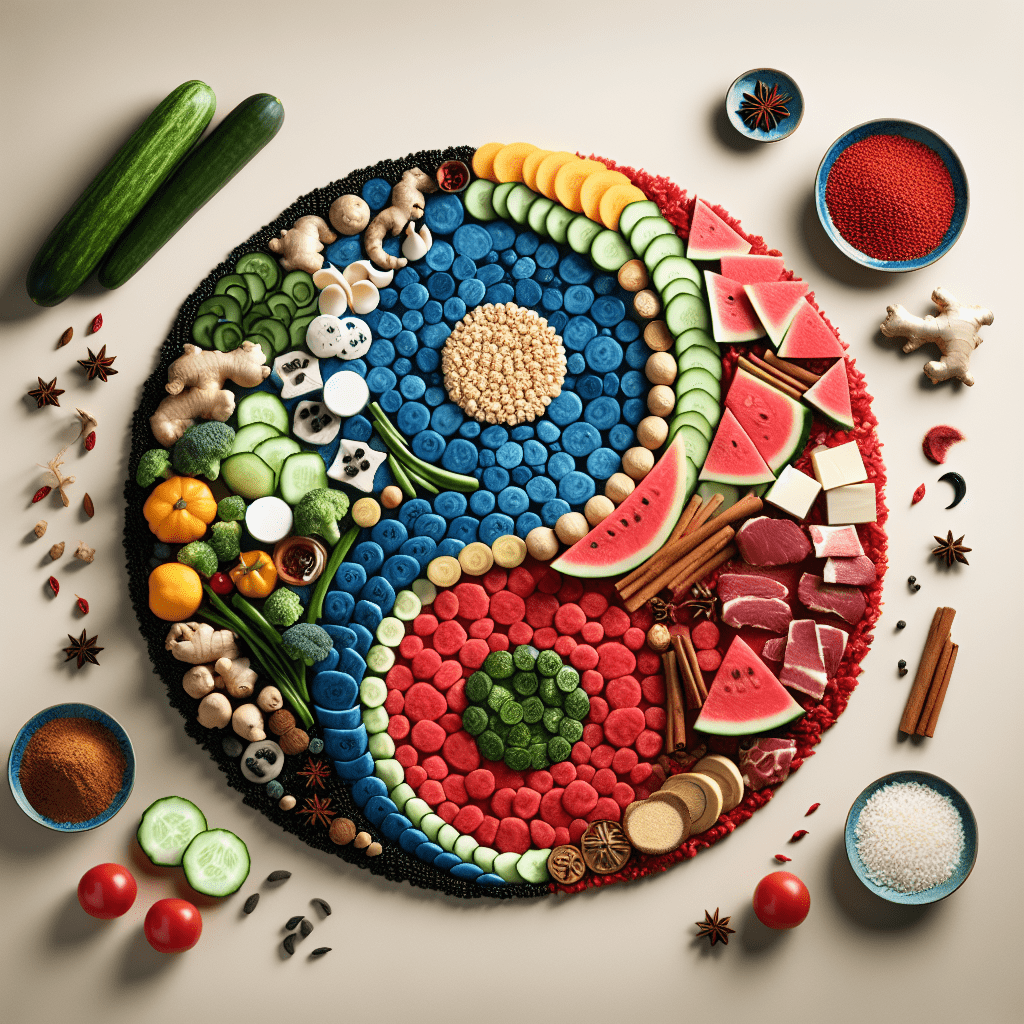Ever felt inexplicably tired, sluggish, or just “off” despite getting enough sleep and taking your vitamins? The answer to your energy woes might be hiding in plain sight—on your plate. Traditional Chinese Medicine (TCM), a healing system with over 2,000 years of wisdom, suggests that the thermal properties of foods can significantly impact your body’s body’s energy flow, or “qi” (pronounced “chee”).
In our modern world of convenience foods and year-round access to all types of produce, we’ve largely lost touch with the ancient understanding that what we eat doesn’t just fuel our bodies—it can either enhance or obstruct our vital energy flow. This disconnect might be why so many of us feel constantly drained despite our best efforts to stay healthy.
Understanding Food Energy in Chinese Medicine
In TCM, foods aren’t just categorized by nutrients, calories, or food groups. Instead, they’re classified according to their energetic properties—specifically, their thermal nature. This concept might seem foreign to those accustomed to Western nutritional science, but it offers profound insights into how our diet affects our overall wellbeing.
Foods in Chinese medicine fall into five thermal categories:
- Cold
- Cool
- Neutral
- Warm
- Hot
It’s important to note that these categories don’t necessarily refer to the physical temperature of the food but rather to the sensation and effect they create within the body after consumption. For example, watermelon is considered “cold” in TCM even if it’s not refrigerated, while ginger is “hot” even when used in room-temperature dishes.
When our bodies are in balance, we naturally feel energetic, clear-headed, and healthy. But when we consistently consume foods that don’t match our body’s needs or the season, we can create imbalances that manifest as various symptoms, including low energy, poor digestion, and even mood disturbances.
The Science Behind Warming Foods Chinese Medicine
The thermal properties of foods in TCM influence several bodily functions:
Circulation: Warming foods in Chinese medicine principles tell us that these foods can enhance blood flow, helping to deliver nutrients and oxygen throughout the body more efficiently. When your circulation improves, you’re less likely to experience cold hands and feet, and more likely to feel energized.
Digestive Fire: TCM considers the digestive system as a cooking pot that needs adequate heat to properly transform food into energy. Consuming too many cooling foods can dampen this “digestive fire,” leading to symptoms like bloating, gas, and undigested food in stool—all signs that your body isn’t extracting the energy it needs from your meals.
Immunity: Your defensive qi, which protects against external pathogens, is closely linked to the thermal balance of your diet. Warming foods that Chinese medicine practitioners often recommend can strengthen this protective energy, especially during colder months when our bodies naturally need more internal warmth.
Metabolic Rate: The thermal nature of foods can either speed up or slow down metabolism. Warming foods tend to invigorate metabolic processes, helping the body to process nutrients more efficiently and maintain consistent energy levels throughout the day.
According to TCM practitioners, the modern diet—especially in Western countries—tends to be overly cooling. This is partly due to the high consumption of raw foods, salads, smoothies, and refrigerated items. While these foods certainly have nutritional benefits, consuming them in excess can gradually slow down your energy flow, particularly if you already have a naturally “cooler” constitution.
Warming Foods to Revitalize Your Energy
If you suspect that your diet might be too cooling, incorporating warming foods that Chinese medicine recommends can help restore balance and boost your vitality. Here are some powerful warming foods to consider adding to your meals:
Warming Spices:
- Ginger: A kitchen staple that promotes circulation and warms the body from the core
- Cinnamon: Excellent for improving digestion and warming the kidneys, which store vital energy in TCM
- Garlic: Enhances immunity while providing warming energy
- Black pepper: Stimulates digestive fire and helps nutrients become more bioavailable
- Turmeric: Reduces inflammation while providing gentle warming properties
Warming Vegetables:
- Root vegetables (carrots, sweet potatoes, turnips): These grow underground and naturally hold more warming energy
- Onions and leeks: Promote circulation and support respiratory health
- Pumpkin and winter squash: Nourish the spleen-pancreas system, which is central to energy production in TCM
Warming Proteins:
- Lamb: Considered the most warming of all meats
- Chicken: Provides moderate warming energy
- Venison: Warming and strengthening
- Eggs: Particularly the yolks offer nourishing warmth
Warming Cooking Methods:
The way you prepare food can also enhance its warming properties. Slow cooking, roasting, and using pressure cookers all increase the warming nature of foods. Conversely, raw preparation methods preserve the cooling properties of foods.
A simple warming breakfast might include oatmeal with cinnamon, ginger, and walnuts. For lunch, consider a hearty soup with root vegetables, onions, and chicken. Dinner could feature roasted vegetables with warming spices and a moderate portion of lamb or other warming protein.
How Cooling Foods Might Be Freezing Your Energy
Just as warming foods can enhance energy flow, an excess of cooling foods can impede it. Cooling foods in TCM include:
- Raw vegetables and salads
- Most fruits, especially watermelon, banana, and citrus
- Cucumber and celery
- Yogurt and milk
- Soy products
- Beer and white wine
- Ice cream and frozen desserts
While these foods have their place in a balanced diet, consuming them in large quantities—especially during colder seasons or if you have a naturally cool constitution—can lead to symptoms such as:
- Fatigue and low energy
- Cold hands and feet
- Loose stools or diarrhea
- Bloating after meals
- Weak immunity
- Menstrual cramps (in women)
- Joint pain that worsens in cold weather
One particularly common modern habit that can deplete energy according to TCM is the consumption of iced beverages. Cold drinks are thought to shock the digestive system and require significant energy to bring them to body temperature before digestion can even begin.
Balancing Your Diet for Optimal Energy Flow
The key to using warming foods in Chinese medicine effectively isn’t to eliminate cooling foods entirely but to create balance based on your individual needs and the current season. Here’s how to approach this balance:
Assess Your Constitution:
Do you tend to run hot or cold? People who feel cold easily, have pale complexions, and prefer warm environments likely have a cooler constitution and would benefit from more warming foods. Those who feel warm most of the time, flush easily, and prefer cooler environments might need a more balanced approach with moderate warming foods.
Honor the Seasons:
Nature provides guidance on what to eat through seasonal availability. In winter, emphasize warming foods like soups, stews, roasted vegetables, and warming spices. In summer, it’s appropriate to incorporate more cooling foods while still maintaining some warming elements to support digestion.
Listen to Your Body:
Pay attention to how you feel after meals. If you consistently feel tired or bloated after eating raw salads or smoothies, your body might be telling you it needs more warming foods to properly process and extract energy from your meals.
Gradual Transitions:
If you’re currently consuming a very cooling diet, transition gradually to more warming foods. Start by adding warming spices to your existing meals, then slowly incorporate more cooked foods and reduce extremely cooling items.
Digital health platforms like EASTCHI AI can provide personalized guidance based on your unique constitution, current health status, and seasonal factors. By analyzing your specific needs through the lens of Five Element Theory, such tools can help you understand exactly which warming foods chinese medicine would recommend for your situation.
Practical Tips for Incorporating Warming Foods
Making the shift toward a more warming diet doesn’t have to be complicated. Here are some simple ways to get started:
Start your day with warmth: Replace cold cereal or smoothies with warm oatmeal, congee (rice porridge), or eggs with warming spices.
Transform cooling foods: If you love salads, try lightly steaming or sautéing the vegetables and adding warming spices like ginger or black pepper.
Sip warm beverages: Replace iced drinks with room temperature water, herbal teas, or warming broths throughout the day.
Use warming herbs and spices liberally: Add ginger, cinnamon, nutmeg, cardamom, or cloves to both sweet and savory dishes.
Cook with warming methods: Favor roasting, baking, pressure cooking, and slow cooking over raw preparation methods.
Balance cooling foods: When eating naturally cooling foods, pair them with warming elements. For example, add ginger to a fruit smoothie or enjoy melon with a few warming spices.
Embrace bone broths: These are exceptionally warming and nourishing, supporting both energy and immunity.
Embracing Ancient Wisdom in Modern Life
In our fast-paced world, it’s easy to overlook the profound wisdom contained in traditional healing systems like TCM. Yet, these ancient insights offer solutions to many modern health challenges, including chronic fatigue, digestive issues, and immune dysfunction.
By understanding and applying the concept of warming foods that Chinese medicine has preserved for millennia, we can make more informed choices about our nutrition—choices that align not just with scientific nutritional values but with the energetic needs of our bodies.
The beauty of this approach is its personalization. Unlike one-size-fits-all diet plans, TCM recognizes that each person’s needs are unique and may change with the seasons, age, health status, and other factors. This personalized approach to nutrition is precisely what makes traditional wisdom so relevant in today’s world.
HerbalsZen’s EASTCHI AI builds upon this foundation, merging ancient wisdom with modern technology to provide truly personalized health guidance. By analyzing your unique constitution through the lens of Five Element Theory and considering seasonal influences, EASTCHI AI can help you understand exactly which warming foods Chinese medicine would recommend for your specific situation.
As you begin to align your diet with your body’s energetic needs, you may notice improvements beyond just increased energy—better digestion, stronger immunity, clearer thinking, and a greater sense of overall balance and wellbeing.
In a world where we’re constantly seeking the next superfood or nutritional breakthrough, perhaps the most powerful approach is actually returning to time-tested wisdom that views food not just as fuel but as medicine—medicine that can either freeze or free the vital energy that sustains our health and vitality.



